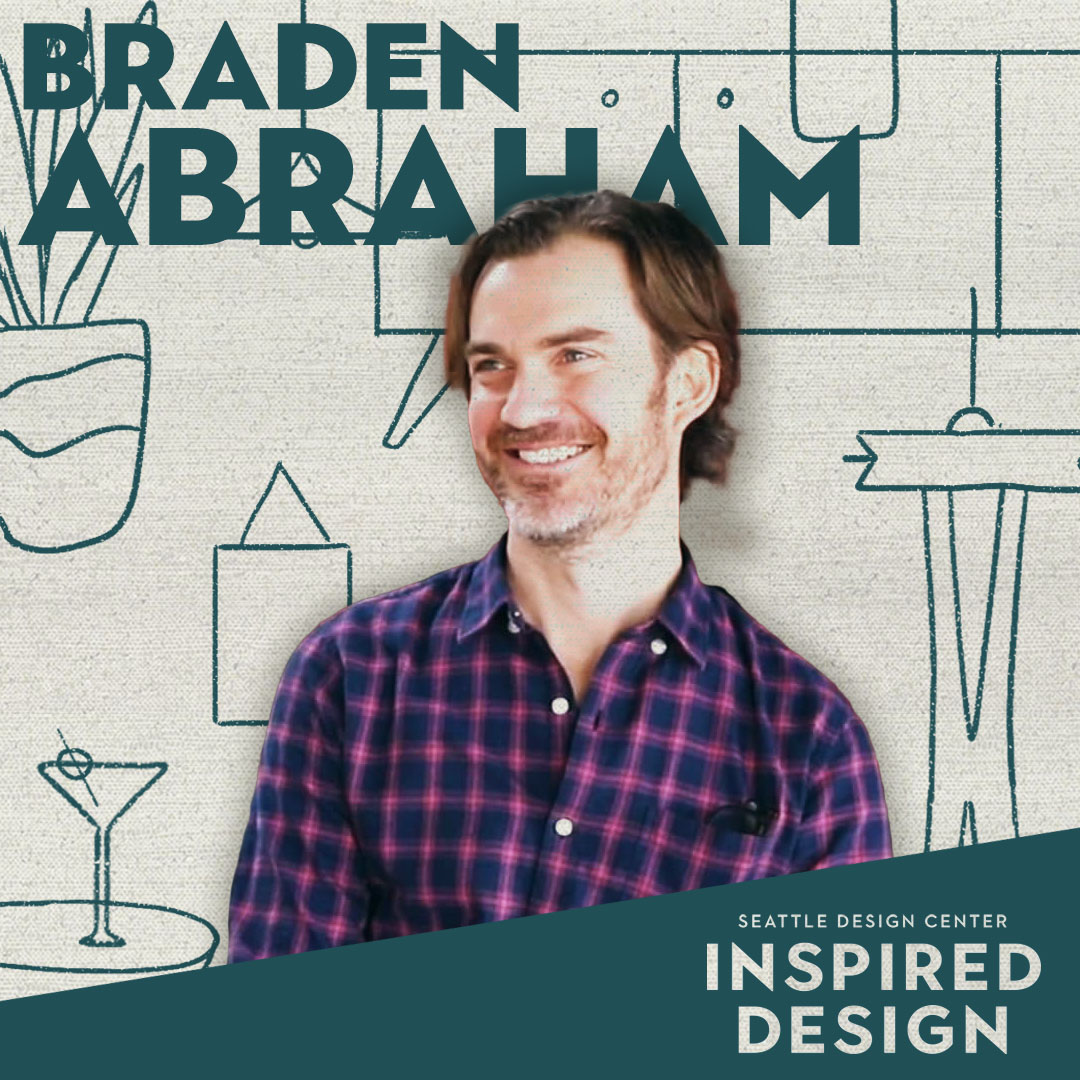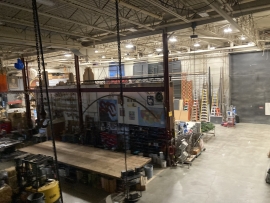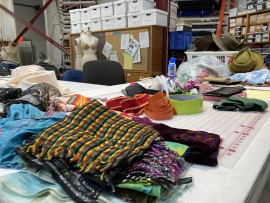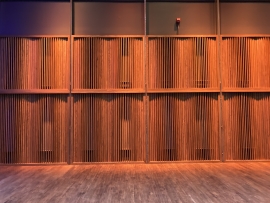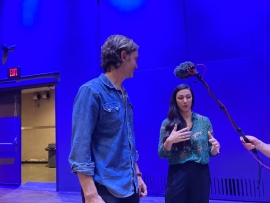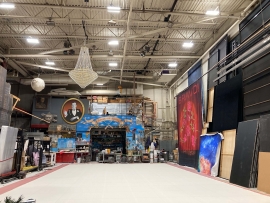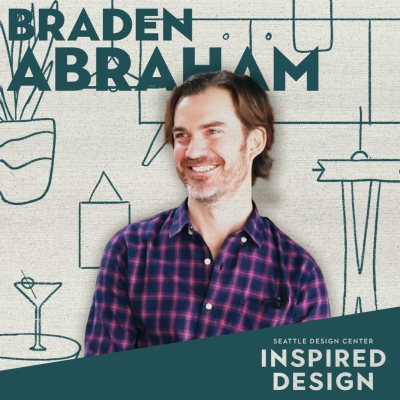
Braden Abraham | Backstage Brilliance
In this episode of Inspired Design, the Artistic Director at Seattle Rep, Braden Abraham, takes us literally behind the curtain to see the intricacies that bring your favorite performances to life. Learn about the interior changes being implemented and how it’ll affect the audiences’ perception and experiences moving forward.
Listen on your platform of choice
[abcf-grid-gallery-custom-links id=”4762″]
Explore this Episode
Learn More
VISION
Theater at the heart of public life.
MISSION
Seattle Rep collaborates with extraordinary artists to create productions and programs that reflect and elevate the diverse cultures, perspectives, and life experiences of our region.
Episode Transcript
Gina Colucci:
I’m Gina Colucci with the Seattle Design Center. Every week on Inspired Design, we sit down with an iconic creator in a space that inspires them.
Braden Abraham:
We’re going into the hallway that’s backstage of the Bagley Wright Theatre. These are dressing rooms along here, and here’s the stage.
Gina Colucci:
Oh wow.
Gina Colucci:
This time of Inspired Design, we went to the Seattle Rep and met up with artistic director, Braden Abraham.
Gina Colucci:
What does an artistic director do?
Braden Abraham:
Yeah. What is an artistic director? I would say my primary role is to oversee the selection of all the plays and then making sure that artistic vision is intertwined with longevity and the sustainability of the theater.
Gina Colucci:
The first thing I noticed about Braden was when he started talking about theater, he just lit up. You could tell that was his passion.
Braden Abraham:
It’s sacred only because it’s a place where people gather, and all the stories and memories and performances that have been here, I think charge it with a certain energy.
Gina Colucci:
The Seattle Rep was founded in 1963. And Braden started working there in 2002 as an intern.
Braden Abraham:
I came here thinking I’d be here nine months. And I’ve been here this long. So you just never know what your path is going to be.
Gina Colucci:
You don’t actually talk to many people who’ve spent their entire career in one place.
Braden Abraham:
Yeah.
Gina Colucci:
How has that shaped you as a person?
Braden Abraham:
I guess we’ll find out. I don’t know yet. I grew up moving a lot. I lived in probably 20 different places in my first 18 years. So for me, part of the adventure is being in one place for a while. And to be at Seattle Rep through a lot of different eras has been a remarkable journey.
Gina Colucci:
I was so excited to see the Seattle Rep from Braden’s perspective.
Gina Colucci:
Oh, wow.
Braden Abraham:
I thought we could just go downstairs and start down there in the shop. This is the production office, the administrative offices.
Gina Colucci:
Oh, cool. Do the [inaudible 00:02:23] work?
Braden Abraham:
They do, actually. Yeah.
Gina Colucci:
So where are we going? What is-
Braden Abraham:
So we’re entering into the scene shop, which is one of my favorite spaces in the whole building. This is where we build all of the sets, all of the props, a lot of props that are specially made for shows. And we do all of the scenic painting for backdrops, sets, all of that. It’s all done here.
Gina Colucci:
We enter an actual workshop. The first thing I noticed was how loud the space was. It’s a giant warehouse with tools and wood and giant sets and props, so you hear the fans and the machines in the background.
Gina Colucci:
How many painters on staff do you have?
Braden Abraham:
We have four painters on staff, I think. And then, we hire an additional to that if we need it. So you can see, this is where we do a lot of building. We store lumber here. We store pieces that we might reuse for other shows. You can see our chandelier collection over there.
Gina Colucci:
That’s fantastic.
Braden Abraham:
All of our saws and stuff. And that’s one of the great things about this facility. This was built in 1983. And one of the reasons why they built a new theater is they wanted to put everything under one roof. That was the goal. And not many theaters actually in the country have that. So the shop is here, and that big door there is where you can move the sets onto the stage. So everything is made here.
Gina Colucci:
That’s amazing.
Braden Abraham:
Yeah.
Gina Colucci:
And I guess just describe the space for me because… How tall are the ceilings? And then could you estimate the square footage?
Braden Abraham:
I should probably know that. I would say the ceilings are 30 feet tall and maybe this is 10,000 square feet. It’s a fairly big space. And actually often, when we have directors come through, they love this space and like, “Can I make my show in here?” This is a really inspiring space for people. And it’s great when we’re doing shows, when we might have one show on stage, and you’ll have one show being built right here in the shop. And so you can walk down here every day, which I often do, and look through those windows and come down on the floor and actually see stuff being made that’s getting ready to go on stage.
Braden Abraham:
And also, when you’re rehearsing, all of the scenic walls are taped out on the floor. We have anything, except for maybe some of the furniture. So we’re even pretending in there, like okay, there’s a wall here. There’s a door here. But the great thing here is that we can walk down here and we can see the door being built, we can see the wall being built, so we can get a sense of what it is before we actually get to use it on stage.
Gina Colucci:
Yeah. And how does that help your actors and even maybe your directors to be able to put those pieces together?
Braden Abraham:
Yeah. Because say a floor might have a slight rake to it, it might be slightly sloped. So the actor can come down, and we’re just on a flat floor in the rehearsal hall, the actor can come down and test what that feels like in their costume shoes. So they get a sense of it. You can see how it’s one thing to imagine where the window is in the back of the set. It’s another thing to actually see through it. So it just gives directors and the actors a better sense of the room.
Gina Colucci:
Yeah.
Braden Abraham:
Yeah.
Gina Colucci:
So that’s very helpful.
Braden Abraham:
Yeah. Yeah.
Gina Colucci:
And are there any little, I guess… You pointed out your chandelier collection.
Braden Abraham:
Yeah.
Gina Colucci:
I see an oversized skull and ribcage.
Braden Abraham:
Yeah.
Gina Colucci:
And then there’s this…
Braden Abraham:
It’s like Winged Victory thing.
Gina Colucci:
Yeah.
Braden Abraham:
That came in before my time. It’s been here for at least 20 years, and I actually can’t tell you which show that’s from, but we do, we collect things here. There’s the old spirits…
Gina Colucci:
So a neon sign-
Braden Abraham:
Neon from the ’80s that got taken out of the lobby at some point and put up there.
Gina Colucci:
Does it still work?
Braden Abraham:
I think it does. And I think when the shop crew, we have a beer 30 on Friday afternoons sometimes, and I think I’ve seen it working for that beer 30. They set up the keg right there.
Gina Colucci:
That’s great.
Braden Abraham:
And what else do we have? There’s a moon from a production of Midsummer Night’s Dream, where the actor Suzanne Bouchard got lowered onto the stage, sitting in that little crescent moon right there. We have old pieces from sets. There’s [Noel Coward 00:07:08] there. There’s the father from my production of Glass Menagerie in 2012, still sitting up there. I don’t know what that gargoyle’s from. I think that’s from Hound of the Baskervilles maybe. Yeah.
Gina Colucci:
And on average, in a non-pandemic year, but how many different productions do you have?
Braden Abraham:
So we do nine productions a year between two spaces in the span of about nine or 10 months. So it is an intense and often grueling schedule in some ways. It’s really exciting and fun, but we’re basically putting up one show a month, if you can imagine what that pace is like. And in the midst of putting up nine shows, none of which we’ve ever done before… So that’s the other thing, is all of our work is made here. We’ve never done it before. We have a template for budgeting it based on past shows, but every single time it’s new. While we’re doing all of that work. We’re also planning the next season. And in the midst of building all of it and putting it up, we’re also raising money for it, doing all the marketing, all of that. All of that’s happening at the same time. So it never stops.
Gina Colucci:
No. Not at all.
Braden Abraham:
Yeah.
Gina Colucci:
And on average, how long does it take from, I guess, conception to opening night?
Braden Abraham:
Well, it depends. It’s all over the place. It’s usually, I would say the practical part of it is probably 12 to 18 months. Some projects are years in the making, two or three years of development before we put it up. Some projects, we find the play and the director two months before we announce it, we put it up the following year, so it might only be eight months. It depends.
Gina Colucci:
And what would be an example of one that took years?
Braden Abraham:
Well, so back in 2014, we did two plays about Lyndon Baines Johnson, All the Way and The Great Society. And this was a huge, huge project for us. It was two epic plays, three hours long. And we actually did them with the Oregon Shakespeare Festival. And we were the first… They premiered both plays. We commissioned one of them, but this was the first place where we put them both together. So you got to see both plays in rotating rep. That project started when I had a conversation with Robert Schenkkan four years earlier, where he described to me an idea he had to write a play about Lyndon Baines Johnson. And even from that moment, I was like, “This is going to be amazing.” And so it took that long to get to that opening night.
Gina Colucci:
And what was that conversation like, to be at the beginning of something? Because you will get plays too that have already been written or they’re remake, but that one was just a fully original.
Braden Abraham:
Yeah. That’s part of what makes this job so fun is when you can get there from the very beginning, from when a play is just an idea. It’s not even a fully formed idea. It’s just the very, very beginning of an idea. But in a special case like that one, when you sit down with a writer like Robert Schenkkan and he describes it to you, you just know that it’s going to be something special because of his enthusiasm, his passion for it, and of course his skill as a writer, his knowledge about it. All of that makes you go, “We have to do this.” And it doesn’t always work out like that one, but that ride is what makes our work so fun. Yeah.
Gina Colucci:
That sounds really special.
Braden Abraham:
Yeah.
Gina Colucci:
Yeah. So what else do we have down here?
Braden Abraham:
Yeah, so let’s keep going. Yeah. So this is the paint floor. And again, you can see a drop that’s laid out that’s about to get painted. I actually don’t know what this is for.
Gina Colucci:
I was struck at how massive this blank canvas was laying on the floor. It took up almost half of the workspace.
Braden Abraham:
What is that? 35 by 20, maybe? 40 by 20.
Gina Colucci:
Yeah. It’s big.
Braden Abraham:
Yeah.
Gina Colucci:
Can you explain what a drop is for…
Braden Abraham:
Yeah. A drop, so if you go to see a show say that has, say it’s a house on a hill with a beautiful vista behind it, that beautiful Vista is all painted. And so it hangs on a pipe that is at the back of the theater, and that pipe is raised, hanging that drop cloth. And then it’s lit by the lighting designer, and the combination of the paint, the perspective, and the lighting gives you that sense that you’re in the Swiss Alps or something like that. Yeah.
Gina Colucci:
Do you have a memory of one that you’ve seen the progression of and it just blew your mind?
Braden Abraham:
Well, they always do. Here at Seattle Rep, we have some of the best artists, artisans in the country. And it’s amazing to come down and watch them put down the layers of paint and see the detail and the perspective begin to develop. But you don’t really know the full depth of it until you see it with light on it. And that’s the other amazing thing about painters, is that they both understand color from just the paint perspective, but they also understand it from the lighting that’s going to be put on it too and how that works.
Gina Colucci:
And they have to collaborate with the lighting designers and [crosstalk 00:12:43]
Braden Abraham:
Well, and the lighting designer… Yeah, exactly. The set designer really is the one who sets the design, including the drops, and then they collaborate rate with the painters to get the effect they want. But there’s conversations happening with the lighting designer for that entire time. Yeah. It’s cool.
Gina Colucci:
That’s really cool.
Braden Abraham:
So let’s keep going, and we’ll go out onto the main stage. So now, we’re going into the hallway that’s backstage of the main theater, the Bagley Wright Theatre. These are dressing rooms along here, and here’s the stage
Gina Colucci:
Oh, gosh. Oh, wow.
Gina Colucci:
I want to make sure you understand how cool this moment was, walking out onto the main stage. You felt connected to how actors must feel when they go out to perform. The energy on the stage was palpable.
Braden Abraham:
I actually haven’t been in here in a while because of the pandemic, and they’ve just torn out the old seats because we’re renovating the space right now, putting in new seating. So this is the first time I’ve actually seen it in a while with all the seats out, which is pretty amazing.
Gina Colucci:
Do you want to take us a little bit through the renovation that you guys are looking forward to? Or you’re in the middle of, actually.
Braden Abraham:
Yeah. So we’re standing center stage right now, and we’re looking out at the house, and the whole main floor, all the seating is gone. And what we’re doing is we’re replacing the seats, which are pushing 40 years old now and have been in need of replacement. So, there’s a couple things that are happening. First, we just needed new seats because they’re worn out. It’s going to give a lot more access. We’re going to have more ADA, more wheelchair spots in better seats of the house, which was really important to us to come into compliance and just offer more accessible seating to more patrons. So that’s going to be fixed.
Braden Abraham:
The other thing that I’m really excited about as a director is… One of the great things about this space is that for a fairly large space, there’s 860 seats, it actually feels pretty intimate because the back wall where you enter the theater is not that far away.
Gina Colucci:
No.
Braden Abraham:
So you can sit in here and feel pretty close to the stage, even if you’re sitting fairly close to the back. The challenge with this space as a director is that the seats have always been wider than the stage. So what it creates is a sight line issue, where your eye… You can’t use the full width of the stage to stage things. Now what we’re doing is we’re actually putting less seats back in, so we’re narrowing the audience, so it’s more in line with the stage. That way we’ll be able to use the full depth of the stage, and more seats will be good seats. So now, almost every seat on the floor will be a great seat.
Gina Colucci:
Yeah.
Braden Abraham:
Yeah.
Gina Colucci:
There’s no bad seat in the house.
Braden Abraham:
There’s no bad seat in the house. I think we can actually honestly say that. And they’ll also be more comfortable. There’ll be more room around them. They won’t squeak, which for me is a big thing. Although you can tell when an audience is restless in here, they’re not quite with you, when the seats start to squeak. But that won’t be there anymore.
Gina Colucci:
That’ll never happen again.
Braden Abraham:
Yeah. And then, you see the balcony. Another characteristic of this space is that there’s a very steep balcony. And often, when actors come in, when we come from the rehearsal hall into here, one of the adjustments that we have to make for the actors is that they just have to… If they’re used to talking like this, they just have to raise their chin about 10 degrees for some moments, just to give a little more access to the people up on top, especially when they’re addressing the audience. They’re giving a soliloquy or talking to the audience some way, just having your chin up just a little bit allows them to see the full room. So it’s a little unnatural, but we try to make it feel natural. There’s great seats up in the balcony.
Braden Abraham:
One of the things that I struggle with, or really just don’t like about this space, honestly, is that the sight lines from the balcony, from an architectural point of view, it’s brilliant because it hits directly to the lip of the stage. So from there to here, you can’t actually see much beyond this.
Gina Colucci:
Okay.
Braden Abraham:
The problem is that, first of all, it cuts that audience off from this audience. So if you’re downstairs, it’s hard to have an awareness of who’s upstairs and vice versa. To me, that really takes away from the experience of theater, which is that you want to feel everybody around you. You want to feel that shared experience of feeling like you’re with the whole audience. And I feel like that’s a challenge in this space.
Braden Abraham:
The other thing is that you can never… With a set, it’s hard to break what we call the proscenium line right here. It’s hard to get stuff out into the house, which is fun sometimes, if you want to really emphasize that connection with the audience, and you don’t want this artificial fourth wall, like we call it, you want to be out there with them. It’s hard to do because of the way the space is designed. So, we push it as much as we can on some shows. And on a particular show called Here Lies Love where we tore out all of seats and made this into a giant Studio 54 disco, we completely obliterated it.
Gina Colucci:
That’s awesome.
Braden Abraham:
But on a typical show, we can’t do that. So that’s just a tension that we have to work with in the space.
Gina Colucci:
I saw mattresses back there. Was that for the…
Braden Abraham:
I don’t know what those mattresses were for, but yeah, that was… That’s a whole story in itself when we did that. That was David Byrne’s musical Here Lies Love, which we did in 2016. And yeah, we tore out all of the seats. We built these risers, these seating risers. We completely transformed the space, so much so that people who had been coming to this theater for 30 years, when they walked in, they did not recognize it. They were completely disoriented. The only thing that looked the same was the balcony because… And in that way, the balcony became a huge advantage for us because it became perfect seating even for this dance floor that we’d put in.
Braden Abraham:
And for that show, the audience and the actors were all in the same space. And we had these moving platforms that went through the audience. So the audience was moving around the action. It was incredible.
Gina Colucci:
What a cool experience.
Braden Abraham:
Yeah, it was really cool. [crosstalk 00:19:32].
Gina Colucci:
Is there plans to do anything like that ever again?
Braden Abraham:
Well, I hope so, but we may need to do it in a different space because we were really fighting the architecture here in a way that was really creative, but also really hard and also very expensive.
Gina Colucci:
Well, you can’t put a price tag on [crosstalk 00:19:53].
Braden Abraham:
Yeah, that’s right. That’s right.
Gina Colucci:
And I guess, you have some of the best actors in the world come through here, and I’m… Did you do any acting?
Braden Abraham:
Me? Well, like most people, I started as an actor and then realized that I was probably better on the other side of the table. So yeah, in high school and in college I acted. And I did have one acting experience or well, a few after college. When I first started out in theater, when I moved here, my girlfriend and I at the time did a production of a Sam Shepard play called Cowboy Mouth, and I built the set and we rehearsed in my apartment. And we did it down at the Speakeasy, the old Speakeasy Cafe, which was down in Belltown and burned down, I think, in 2002 or something like that. So yeah, I did a bit of acting.
Gina Colucci:
And well, I guess quickly though-
Braden Abraham:
Yeah.
Gina Colucci:
With the new seats coming in, where will your favorite seat be?
Braden Abraham:
Well, it’s funny. I don’t sit much. As the director, I like to stand in the back because for me, I want to both watch the play, but I also want to feel the audience. And it’s harder for me if I’m sitting in the house. And even on opening night, I don’t sit. I rarely do.
Braden Abraham:
In fact, one time, my wife… I sat. I was like, “I’m going to sit for this one,” and she was with me and we sat. She [inaudible 00:21:28] me in intermission, she was like, “Don’t ever do that again,” because I was fidgeting. And [crosstalk 00:21:34] no, I probably shouldn’t.
Braden Abraham:
But my favorite seats are usually in the middle, so you can get a full sense of the full stage, but also be close enough that you really feel intimate with the actors. Actually, one of the first shows I ever saw was in this space. I came here on a school trip from Anacortes in 1989. I saw Sunday in the Park with George. I sat right up there. And of course, when I came in this space then as a kid, having maybe been to one or two other theaters in my life, I was just completely blown away by the show and being in here and what was possible in terms of what a theater show could be.
Braden Abraham:
And we’ve launched countless new plays here. There’s just a lot of history here. And I think that’s been one of the hardest things about the pandemic and being closed is that the space is just empty. And we talk about there’s the cliche about a theater being a church. And I don’t really subscribe to that except for maybe the fact that it’s sacred only because it’s a place where people gather, and all the stories and memories and performances that have been here, I think, charge it with a certain energy. In that way, I guess it is a holy place to me because all of those people have been here and shared stories here and shared ideas and questions and all of that. I think that’s what makes it special.
Gina Colucci:
I’ve heard that before, of where people gather, and it’s interesting how our perception of that’s changing with these last few months and the pandemic. What are your hopes as you start to reopen and bring that energy back?
Braden Abraham:
Just by being together again, I think people are going to, I hope, just remember and appreciate what it’s like to be together for theater and for dance and for sports. It’s just by its very nature, healing. And it reminds us of who we are, and it reminds us of what we hold in common with each other. So yeah, that’s my hope.
Gina Colucci:
I hope that too.
Braden Abraham:
Yeah.
Gina Colucci:
You’re a big baseball fan as well.
Braden Abraham:
Yeah.
Gina Colucci:
And are there any similarities between being in a sports stadium and being in a theater that you can make?
Braden Abraham:
Oh, I think so. Especially baseball, just the drama, the pace of life, all of the unpredictability of what could happen. And certainly also like with theater, just all of the rich tradition of the players and the game and the memories of what it means to experience the sport together.
Gina Colucci:
You can all root for and against.
Braden Abraham:
Yeah, yeah. Yeah.
Gina Colucci:
I’m seeing this, quickly as we’re walking out, there’s a blow… I first thought it was a dolphin, but it looks like a plane, an inflatable plane and some funny little-
Braden Abraham:
These are all mementos from past productions and things that the stage hands have picked up. I don’t know where some of these things are from.
Gina Colucci:
Like the disco ball.
Braden Abraham:
Disco ball.
Gina Colucci:
A monkey.
Braden Abraham:
Yeah.
Gina Colucci:
A Mexican wrestling mask cut out [crosstalk 00:25:18].
Braden Abraham:
So now, we’re back in the hallway, backstage. That’s the costume shop.
Gina Colucci:
Can we check that-
Braden Abraham:
Yeah. You can go in here.
Gina Colucci:
I just… Oh my gosh. I grew up playing dress up.
Braden Abraham:
Yeah.
Gina Colucci:
And this just looks-
Braden Abraham:
Oh yeah. This would be your young self’s dream. [crosstalk 00:25:43] yeah.
Gina Colucci:
I still love a good costume.
Braden Abraham:
Well, yeah, this is it.
Gina Colucci:
Oh, this is awesome.
Braden Abraham:
So this is where we build all the costumes for the shows. You can see there’s some of the racks here with old costumes. We just wrapped doing an actual film of our public works program, Winter’s Tale. We filmed a musical version of Winter’s Tale outside because of the pandemic. We’re like, “Well, we can’t do a show on stage yet. Let’s do a film.” So we’ve just wrapped that. So there’s a lot of stuff here that’s going back into storage after it was used.
Gina Colucci:
Where do you store all [crosstalk 00:26:19] is it here on site too?
Braden Abraham:
Yeah. We have some storage on site. We don’t keep everything, but we keep a lot of stuff, and we borrow stuff from UDub. Looks like there’s some stuff over there. But most of the stuff for our shows is built here by artisans who work here, and they are incredible. It’s amazing to come in here. Again, you could be in rehearsal, and you come in and they’re building the costume for a particular role. And that’s the dressing room over there where the actors come in and they try stuff on, they fit them. They take all their measurements. So everything’s fitted specifically to the actor, but just the work. That’s one of the things I love about the theater. It’s one of the last few places where everything is handmade right in the same location. And you can actually watch a garment being made, and their craft is incredible.
Gina Colucci:
There’s also a ton of shoes above us.
Braden Abraham:
Yeah. There’s shoe storage up there. And some of these shoes are actually made for specific shows. Back here, we have our dye room. So where we can dye garments and do leather work. That’s hair over there, so where actors get haircuts and get made up with wigs. We have an amazing wig maker, Joyce [Degenfeller 00:27:56], who’s just phenomenal. She’s been here for 30 years, 30 plus years. She’s one of the best in the business. Yeah, this is the dye room.
Gina Colucci:
I like the half mannequin legs standing.
Braden Abraham:
Yeah. You can see a big piece of leather there, hanging up, ready to be made into a hat or something.
Gina Colucci:
It’s like everywhere I look is a different era.
Braden Abraham:
Yeah, exactly.
Gina Colucci:
It’s so cool.
Braden Abraham:
This is all eyeglasses and bracelets, jewelry. One time during a gala, I came here and got my tuxedo on because we have our gala here, and I couldn’t find my cuff links. I’d forgotten them at home. So I ran down here and I was like, “Do you have any cuff links?” And they’re like, “Do we have cuff links? Here. Open this drawer.”
Gina Colucci:
[crosstalk 00:28:42] Men’s accessories.
Braden Abraham:
Yeah. I know. It’s the perfect place. Right?
Gina Colucci:
I know. There’s just, how many? One, two, three, four, five, six, seven, almost over 10 just drawers of glasses.
Braden Abraham:
Yep.
Gina Colucci:
Oh my gosh. The fun you could have.
Braden Abraham:
I know. Total dress up dream, I’m telling you.
Gina Colucci:
Totally. How is it going, I guess watching your actors as you’re directing a play, go from the production and then putting their costumes on, and then doing a run through. Is there a huge difference?
Braden Abraham:
It is… I don’t know if it’s a huge difference, but it’s one of the final pieces, and I think it’s different for every actor. Some actors, they really can find their character much more easily once they get their shoes on because it just affects the way they walk in a different way. And that can be true with a certain costume. It doesn’t give them the character, but it gives them an added sense of being in that world. And it’s just another key part of it. So yeah, it can be one of the final pieces when they get that. And it’s like, oh, this comes together in a different way.
Gina Colucci:
That process would be really cool to watch.
Braden Abraham:
And speaking of rehearsal, this is our main rehearsal room actually, right here. This is the poncho form. This floor is a floor that we put in, in the early ’90s for a production of Cider House Rules.
Gina Colucci:
Oh wow.
Braden Abraham:
It was an adaptation of the John Irving novel that started here and ended up going to Broadway. And the first production… This was our second space before we built a second theater, where we would do a lot of new plays, and there’s some seats that fold out here. And so it’s a 99 seat, what we call a black box theater because it’s all in one space.
Braden Abraham:
The floor is original. Everything else is new that we redid just a few years ago. And when we went about designing the space, I said, “I want to keep the floor because there’s a patina to it from all of the rehearsals and performances that have been here.” And it adds a warmth to the space that just feels right for a space that’s really the creative heart of our building in many ways, because this is where we make the shows. But everything else is new. The seats are new, and they’re much more comfortable than the old seats, which were like the jump seats in a Toyota pickup truck or something. They’re much more comfortable. These panels are for acoustics. And-
Gina Colucci:
And can you describe those? Because they’re very modern, but artistic looking in a way.
Braden Abraham:
Yeah. And they’re wood slatted, fanned panels that go up against the wall. And we’ll go outside, and you can see there’s actually a window there, where with the shade up, as it is now, you can see into the rehearsal hall. And that was part of what we want to do with the space is give people a little peek into the room if we wanted to, without feeling like if you’re in here, you’re in a fishbowl.
Braden Abraham:
But it also comes out of the floor. It matches the floor and brings that warm energy up the wall into the room. And you have the cooler panels behind it, the acoustical panels, which give the space a nice warmth as well in terms of sound.
Braden Abraham:
Yeah. I love the space. I love the height of the ceiling. Even though it’s a relatively small cozy space, the height of the ceilings make it feel [crosstalk 00:32:25].
Gina Colucci:
And how high would you say these are?
Braden Abraham:
They’re also probably about 30 feet, maybe 25 feet. So now this space functions both as a rehearsal hall, as a space where we workshop new plays and might do presentations, but it’s also where we might do an opening night party or an event or that kind of thing.
Gina Colucci:
Yeah.
Braden Abraham:
Yeah.
Gina Colucci:
It’s cool. I love how the lighting too is almost symmetrical throughout. It just adds this element.
Braden Abraham:
Yeah. And we can hang lights up here for shows and stuff too and add to it. But this allows us to have a few looks.
Speaker 3:
Seattle Design Center is the premier marketplace for fine home furnishings, designer textiles, bespoke lighting, curated art, and custom kitchen and bath solutions. We are located in the heart of Georgetown, open to the public Monday through Friday with complimentary parking. Our showroom associates are industry experts known for their customer service. We are celebrating new showrooms and added onsite amenities. Visit seattledesigncenter.com for more information about our showrooms and our Find a Designer program.
Gina Colucci:
Now the halls that we previously walked through, not many people would see that-
Braden Abraham:
Those are public spaces. That’s all backstage. So now we’re in the lobby, and I can show you this final theater.
Gina Colucci:
[inaudible 00:33:47].
Braden Abraham:
So now we’re in the part of the building that was built in 1997. So the original part was ’83 and this is ’97. And the goal was to build a larger second stage than the space we were just in, to be able to offer more programming. And let me see, make sure the lights [crosstalk 00:34:20]
Gina Colucci:
As we walk to the second theater, Braden reaches for the lights, but the room isn’t dark. There’s another light source coming from the main stage.
Gina Colucci:
I like there’s just a random little light lantern in the middle of the [crosstalk 00:34:34]
Braden Abraham:
That’s what we call the ghost light. And that’s to keep some light in the space at all times. Theater people are superstitious. And if the theater goes completely dark, that’s no good.
Gina Colucci:
Okay.
Braden Abraham:
So we keep a light on all the time. It’s called the ghost light.
Gina Colucci:
Okay. You were serious. I love that.
Braden Abraham:
Very serious.
Gina Colucci:
And what else? What other superstitions are there that I need to know about?
Braden Abraham:
Oh, well, see, this is another way in which baseball and theater has similarities. Something might work a certain night, and I don’t know, you do it exactly the same the next night, or you don’t change your pre dinner routine so that you don’t mess up your performance. There’s lots of different little things. You don’t say the name of Shakespeare’s the Scottish play in the theater. Well, I won’t say the real name, but I think you know-
Gina Colucci:
You can’t.
Braden Abraham:
I can’t. All kinds of quirky little things. And every theater artist might have something different.
Gina Colucci:
Yeah. I love that. One I know is you say, “Break a leg.”
Braden Abraham:
You say, “Break a leg.” You never say… Yeah, you never say, “Good luck.”
Gina Colucci:
No.
Braden Abraham:
I know. It’s okay.
Gina Colucci:
There’s not [crosstalk 00:35:59].
Braden Abraham:
I’m not that superstitious. So I love this space. So this is a smaller proscenium space. The first space we were in is 855 seats, 860 seats. This is 280. This is a beautiful space to do smaller cast plays, dramas and comedies, solo work. I think it’s one of the… Yeah, I think it’s one of the best spaces in the building. I love the proportions of this space. The opening to the stage is actually quite tall, but I love that you have the possibility of height in here.
Braden Abraham:
I directed a production that was set in a cabin in Idaho, and we took out floor panels and put trees way down in the basement and put them all the way up into the rigging. And you really got the sense of verticality in the space. And then I’ve done other shows in here where it was only 12 feet that you could see, and it felt very letter boxed, almost like a movie. And so that works well too. But yeah, it’s just great, in terms of being very intimate with the actors, hearing every single word without a lot of effort. It works well for those kinds of shows.
Gina Colucci:
Yeah. And one of the biggest differences I noticed from the first year we were in, and you pointed this out there, is the upper level and how it’s more at a curve angle so that if you were up there, you do see the audience-
Braden Abraham:
That’s right.
Gina Colucci:
From the first.
Braden Abraham:
You feel much more connected, which I really like in a theater. I like it when the audience… You can see everybody, and there’s something that’s special about that. Yeah.
Gina Colucci:
I don’t know why my mind goes here, but anytime I’m in a theater and then these little boxes on the side, I always think that’s where the royalty sit. [crosstalk 00:37:56] I don’t know where that came from.
Braden Abraham:
I really hate these boxes. I got to tell you, if I could take them out, I would, and they don’t help with the sight lines upstairs. And you can see that we actually took the seats out of this front one and just made it a lighting position because the boxes aren’t good for anything really but being seen, like if you’re royalty. They’re not very good for watching a play. But that said, there are people who sometimes request these other two, I think just because it gives you more room to stretch out. I don’t think it’s particularly about the view of the play, but maybe it is. I don’t know. Yeah.
Gina Colucci:
Do you ever incorporate those in the play?
Braden Abraham:
Oh yeah. We’ve used them several times. I remember a production of The Beard of Avon, actually before I started working here, by Amy Freed, and Queen Elizabeth made her entrance there. Of course she would, right?
Gina Colucci:
Of course.
Braden Abraham:
And we’ve used them in other shows too. Yeah, they’re good for that sometimes.
Gina Colucci:
If you weren’t excited by our behind the scenes tour, get ready. Listening to Braden talk about what’s coming up this season, it’s going to get you hyped about the magic of the theater. And you’re going to go buy tickets.
Braden Abraham:
I didn’t even talk about our public works program, but it’s one of the programs I’m most proud of that we started in 2014. It’s a program that we make work with our community throughout the year. We have different residencies with different organizations. We teach theater classes, they come here and see shows. We do potlucks together with all these different community organizations. And at the end of the year, we do a large community-based production that involves professional actors, directors, and 80 or so community members and partner arts groups. So it ends up being about 150 people on the stage, all of Seattle, or representatives of all of Seattle, making a show together, which is really special.
Braden Abraham:
And of course, we haven’t been able to do that show in its traditional sense for the last two years. But this year, we decided we’d make a film because for some reason we thought that would be easier, but it did allow us to work with smaller groups of people and do something we hadn’t done before.
Braden Abraham:
And then, when the Bagley Theatre, the big theater, reopens in January, our first show in there will be a piece about Fannie Lou Hamer, the civil rights activist. And that’s written by Cheryl L. West, playwright who’s based in Seattle, but is produced all of over the country. It’s told through story and song, and it’s a beautiful solo show about Fannie Lou Hamer.
Braden Abraham:
And then we have Freestyle Love Supreme by a guy you may have heard of, named Lin-Manuel Miranda, who wrote a little show called Hamilton. [crosstalk 00:40:54] but Freestyle Love Supreme is the origin of Hamilton in some ways. It’s where Lin and a lot of his long term creative partners who went on to work on Hamilton and In the Heights, another show that we did a few years ago, it’s how they started, which was in the basement of the Drama Book Shop in New York, kicking around and doing an improv hip hop show.
Braden Abraham:
And so that show went to Broadway more recently, and now they’re doing a tour and we’re going to be one of the first theaters in the country to host a tour of that. It’s going to be really fun. Every night’s going to be different, because it’s a total improv show. It’s based on the audience. We’re going to have some special guests.
Braden Abraham:
And then after that we’re doing a new production of Ibsen’s classic Ghosts, which is a really resonant and beautiful, classic play to be doing right now. And Bruce, the new musical about the making of Jaws, which is so much fun, so much fun. Even my daughter who’s 11, who refuses to see Jaws because she’s convinced that it’s too scary for her still, she knows what Jaws is, this movie that was made in the ’70s. And the movie is really about this younger, scrappier group of filmmakers led by a 26-year-old Steven Spielberg, trying to figure out how to make this film and not have it lead to disaster.
Braden Abraham:
And of course, one of the things that makes the film so brilliant is that you don’t see the shark until the end, but really practically why that was is because Steven Spielberg had to improvise because the mechanical shark didn’t work for most of the filming.
Braden Abraham:
And then we have two new plays in the smaller theater, a play called Teenage Dick, which is a very liberally adapted version of Shakespeare’s Richard III set in the high school that’s just hilarious and scathing and fun and great for young actors.
Braden Abraham:
And then we’re also doing a play called Selling Kabul by a playwright named Sylvia Khoury. And that play could not be more timely in terms of what’s happening in Afghanistan. So it’s a beautiful family drama. So we have a really wonderful lineup. I’m looking forward to it.
Gina Colucci:
And so diverse.
Braden Abraham:
Very diverse.
Gina Colucci:
Yeah.
Braden Abraham:
Yeah. You get a lot of different perspectives and stories and styles. But yeah, it’ll be a fun ride. When I put a season together, I really think about the whole journey for the audience. And I’m really excited about what this year has to offer.
Gina Colucci:
Inspired Design is brought to you by the Seattle Design Center. The show is produced by Larj Media. You can find them larjmedia.com special thanks to Michi Suzuki, Lisa Willis, and Kimmy Design for bringing this podcast to life. For more, head to seattledesigncenter.com, where you can subscribe to our newsletter and follow us on social media.
Gina Colucci:
Is there an iconic Northwest creator that you want to hear from? Head to our website and leave a comment.
Gina Colucci:
Next time on Inspired Design, we sit down with Gerard Tsutakawa and visit his exhibit at the Wing Luke Museum.
Gerard Tsutakawa:
My father did all his work in this house, and I grew up here and worked in his studio and moved away and then came back and continued to work here.


